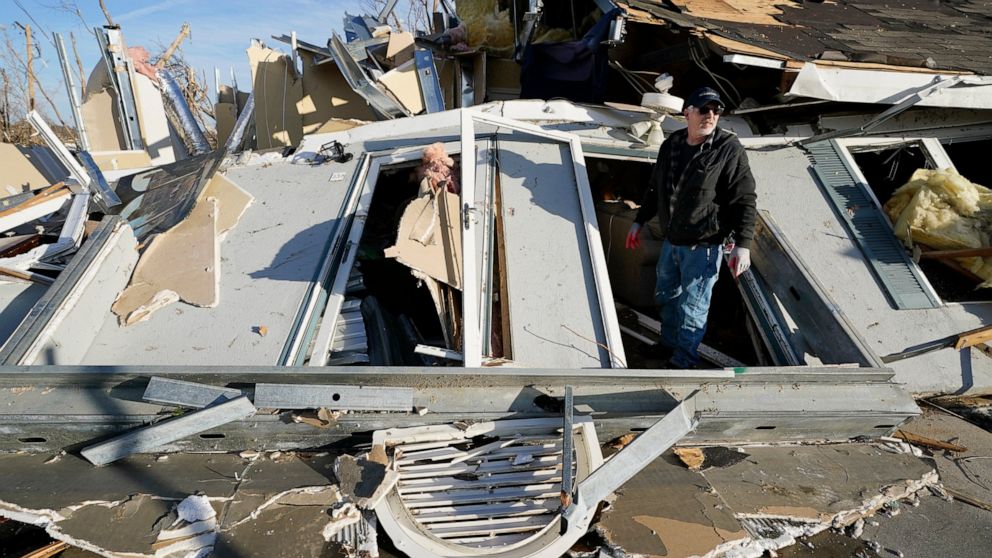EXPLAINER: Was tornado outbreak related to climate change?
Unusually warm temperatures and a storm system moving east linked to the La Nina weather pattern helped create the conditions necessary for the monstrous tornadoes and severe weather that tore through parts of the the Midwest and South
December 12, 2021, 3:46 PM
6 min read
Share to FacebookShare to TwitterEmail this article
3:12
One of the storms traveled more than 200 miles and may have triggered one of the longest tornado tracks in U.S. history.
The Associated PressWASHINGTON -- The calendar said December but the warm moist air screamed of springtime. Add an eastbound storm front guided by a La Nina weather pattern into that mismatch and it spawned tornadoes that killed dozens over five U.S. states.
Tornadoes in December are unusual, but not unheard of. B ut the ferocity and path length of Friday night's tornadoes likely put them in a category of their own, meteorologists say. One of the twisters — if it is confirmed to have been just one — likely broke a nearly 100-year-old record for how long a tornado stayed on the ground in a path of destruction, experts said.
“One word: remarkable; unbelievable would be another,” s aid Northern Illinois University meteorology professor Victor Gensini. “It was really a late spring type of setup in in the middle of December.”
Warm weather was a crucial ingredient in this tornado outbreak, but whether climate change is a factor is not quite as clear, meteorologists say.
Scientists say figuring out how climate change is affecting the frequency of tornadoes is complicated and their understanding is still evolving. But they do say the atmospheric conditions that give rise to such outbreaks are intensifying in the winter as the planet warms. And tornado alley is shifting farther east away from the Kansas-Oklahoma area and into states where Friday's killers hit.
Here's a look at what's known about Friday's tornado outbreak and the role of climate change in such weather events.
WHAT CAUSES A TORNADO?
Tornadoes are whirling, vertical air columns that form from thunderstorms and stretch to the ground. They travel with ferocious speed and lay waste to everything in their path.
Thunderstorms occur when denser, drier cold air is pushed over warmer, humid air, conditions scientists call atmospheric instability. As that happens, an updraft is created when the warm air rises. When winds vary in speed or direction at different altitudes — a condition known as wind shear — the updraft will start to spin.
These changes in winds produce the spin necessary for a tornado. For especially strong tornadoes, changes are needed in both the wind’s speed and direction.
“When considerable variation in wind is found over the lowest few thousand feet of the atmosphere, tornado-producing ‘supercell thunderstorms’ are possible,” said Paul Markowski, professor of meteorology at Pennsylvania State University. “That’s what we had yesterday.”
There's usually a lot of wind shear in the winter because of the big difference in temperature and air pressure between the equator and the Arctic, Gensini said.
But usually, there's not a lot of instability in the winter that's needed for tornadoes because the air isn't as warm and humid, Gensini said. This time there was.
WHAT CONDITIONS LED TO STORMS OF THIS SCALE?
A few factors, which meteorologists will continue to study.
Spring-like temperatures across much of the Midwest and South in December helped bring the warm, moist air that helped form thunderstorms. Some of this is due to La Nina, which generally brings warmer than normal winter temperatures to the Southern U.S. But scientists also expect atypical, warm weather in the winter to become more common as the planet warms.
“The worst-case scenario happened. Warm air in the cold season, middle of the night,” said John Gordon, a National Weather Service meteorologist in Louisville, Kentucky.
Once the storm formed, exceptionally strong wind shear appears to have prevented the tornadoes from dissipating, experts say. Tornadoes are thought to die off when thunderstorm updrafts lose energy.
Tornadoes typically lose energy in a matter of minutes, but in this case it was hours, Gensini said. That’s partly the reason for the exceptionally long path of Friday's storm, going more than 200 miles (322 kilometers) or so, he said. The record was 219 miles (352 kilometers) and was set by a tornado that struck three states in 1925. Gensini thinks this one will surpass it once meteorologists finish analyzing it.







